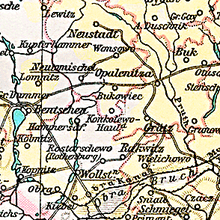Hauländer

As hauländer (also Dutch , Polish Hollendrzy , Holędrzy , Holendrzy , Olędrzy , Olendrzy - Old Polish for the Dutch ) in were Prussia and Poland-Lithuania German and Dutch settlers referred to in royal (or at least noble) lands - the so-called domains were settled - . Until 1807 they were mainly found in Posen and East Prussia .
They are colonists who essentially had two tasks to perform. First of all, many of these colonists had to cultivate the land allotted to them . In addition to clearing , this primarily meant draining swamps and other hydraulic engineering measures. Since the necessary know-how was circulating in Lower Saxony, the Netherlands and Flanders in particular, immigrants from these already densely populated areas were recruited in particular, but by no means exclusively. The second essential task was then the cultivation of the land. Initially, they paid nothing for the country. However, they paid annual interest. So one can speak of a kind of lease.
Hauländer settled in their own villages, the Hauländereien. For them a more liberal law applied than for the usual peasant in Prussia, who was in bondage to the respective landlord / junker and was therefore his serf . The agreements with the aristocratic landowners ensured the Haulländer their status .
Hauländer versus Holländer and Olędrzy

In Polish literature there was no distinction between the Olędrzy and the Dutch and Hauländer in German literature . The Polish name Olędrzy (in all forms of old Polish) always refers to the Dutch or the settlers from the area of today's Netherlands , focusing initially around Paslek (Preußisch Holland) and in the area of the delta of the Vistula populated based on the amelioration . The pattern of Dutch colonization was particularly followed in the 16th and 17th centuries by Mennonites from the Netherlands, but increasingly also by other ethnic groups up to the 19th century. B. the German-Protestant settlers and the Poles in such settlements continue to be called Olędrzy , although according to the modern researcher Zbigniew Chodyła between the years 1527/1547 to 1864 of the at least 1700 Dutch settlements in Poland-Lithuania only 300 actually ethnic-Dutch farmers lived.
According to German-language literature, however, a distinction was made between the terms Hauländerei and Holländerei , and the name Holländer for the settlers from northern and eastern Germany was replaced by Hauländer .
literature
- Joachim Rogall (ed.): Land of the great rivers. From Poland to Lithuania (= German history in Eastern Europe ). Siedler, Berlin 1996, ISBN 3-88680-204-3 .
- Joachim Rogall: b) The "Dutch" . In: The Germans in the Posener Land and in Central Poland (= Wilfried Schlau [Hrsg.]: Study book series of the Ostdeutscher Kulturrat Foundation . Volume 3 ). Langen-Müller, Munich 1993, ISBN 3-7844-2444-9 , chapter "3. New rural settlement", p. 41-45 .
- Kurt von Staszewski, Robert Stein: What were our ancestors? Official, occupational and class names from Old Prussia (= individual publications of the Association for Family Research in East and West Prussia eV Vol. 2, ZDB ID 570710-9 ). Self-published by the association, Königsberg 1938.
- Zbigniew Chodyła: Zarys najstarszych dziejów osad olęderskich w Puszczy Pyzdrskiej 1746–1793 . Pyzdry 2015, ISBN 978-83-943651-0-3 (Polish, online [PDF]).